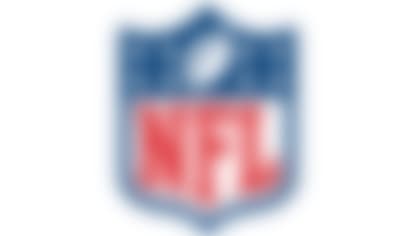In his robust Inside The NFL notebook below, NFL Network's Albert Breer touches on multiple topics, including (click on each link to take you directly to the topic):
» Four things he's looking forward to in Week 3.
» Which Jet compared Tim Tebow to Reggie Bush ... kinda.
» One preseason prediction that ultimately will prove both wrong and right.
» And much more, beginning with why young quarterbacks are having so much success ...
One AFC quarterback coach popped open his iPad early last week to check out what everyone in the NFL was buzzing about -- the eye-popping regular-season debut of Washington Redskins rookie Robert Griffin III.
What followed was a revelation.
"They're running Baylor's offense," the coach explained. "That's where the runs come from, all the screens. And I don't blame them. You have to do things like that. Somehow, you have to reduce the learning a kid has to do if you're going to have him play that early in his career."
The 2012 youth movement at the quarterback position has been well documented. Ten of the league's 32 teams are starting first- or second-year players at the position (see table on the right). Figuring out why this is happening is a more complicated proposition than it might seem to be on the surface.
Some attribute it to the pressure to fill the quarterback position in today's pass-happy NFL. That pushes teams to draft a guy -- sometimes any guy -- early, which foists another layer of pressure on the club to play the draftee. That can explain a good deal of this, since nine of the 10 quarterbacks in the table to the right were top-35 draft picks.
Others think the quarterbacks are also more ready.
"Really, by playing them, we're giving credit for the years they spent growing up," Seattle coach Pete Carroll said over the phone. "And it's relative in the college game with high school kids coming in, too. They're accelerated in developing, and they come in and prove they can play. Times have changed. It's obvious, and you saw it with Andy (Dalton) and Cam (Newton) last year."
Carroll has credibility, in that he's starting the one quarterback (Russell Wilson) in this 10-man group who was selected outside the upper reaches of the draft, and that he handed the keys to a true freshman (Matt Barkley) in his final year at USC.
But there are some who disagree that the guys are more ready. Can they play? Sure. But not always in the traditional NFL way.
"I actually think they're less ready, because of the spread (in college)," said one NFC personnel executive. "In some of these cases, like (with Indianapolis), you say, 'Well, we're gonna be (crappy) anyway, so let's get him reps.' And in other situations, like Seattle, guys win the job. I think it's a fluke, so many guys starting. That's not the norm; it's just the way it's fallen."
How do you marry Carroll's viewpoint with that exec's perspective? Well, in a way, those opinions were merging right there on the screen of the aforementioned quarterback coach's iPad last week.
Griffin is, indeed, ready to compete in the NFL, because of his maturity, intelligence and athletic ability. But since he's coming from Baylor's spread offense, the learning curve is steep. So instead of forcing Griffin to adjust, Redskins coach Mike Shanahan and offensive coordinator Kyle Shanahan have allowed RG3 to run plays that give him the best chance to succeed now. And the Shanahans will gradually work in their offense.
It could create a problem, of course, if Griffin were to go down, with Washington's other quarterbacks having less aptitude for the Baylor scheme. But the adaptability of the Shanahans -- and coaches elsewhere, too -- seems to be as big a factor in the young quarterback's readiness as anything.
"The greatest example of that was what (Denver Broncos offensive coordinator) Mike McCoy did with (Tim) Tebow in Denver last year," an AFC personnel exec said. "They adapted the offense to his strengths, and that's just great coaching. When you can marry the system with the player, that's perfect. The coaches that are adaptable and flexible are the best coaches, guys who tailor to the strengths of the players and not always the system."
Another example came last year with Newton in Carolina, where coach Ron Rivera and offensive coordinator Rob Chudzinski installed read-option elements that the quarterback ran at Auburn.
Which leads us to another explanation for this QB youth movement: More coaches are part of the draft process. In the case of Rivera and Chudzinski, meetings with Newton's college coaches on campus were vital. When a coach drafts a player, he immediately understands him better.
"It used to be that general managers would pick the players and hand them over to the coaches," an AFC college scout said. "Now coaches are involved, they're evaluating these guys, they know the strengths and weaknesses, and that gives them a better opportunity to structure an offense around them. They can better utilize their strengths, mask weaknesses, and you see guys doing a tremendous job with that."
Brooks: Making life sweet for RG3
Bucky Brooks explains exactly how the Redskins' offensive schemes take advantage of Robert Griffin III's unique skills. **More ...**
Of course, what remains central to all this is every team's knowledge that having a star at the position gives you a chance in today's NFL. As long as that holds true, general managers and coaches who don't have such a star will be searching for one, and that means high draft picks will be spent and playing time will be afforded early.
So if a quarterback's not quite ready to execute your style of play, then you adapt to his. It only makes sense.
Which is exactly what that iPad would tell you.
Four things to look for in Week 3
1) The face of the New England Patriots' offense. I don't think receiver Wes Welker's diminished playing time is the result of anything personal after a sometimes-contentious contract dispute that took place this offseason. I do think it could be business. The Patriots have two young tight ends signed through the end of the decade. Their second-year tailback (Stevan Ridley) has 39 carries through two games. And check out what quarterback Tom Brady told me regarding the re-energized run game: "It's what we've been working on in the spring and through training camp, so I don't think it surprised me in that sense, but maybe if you went from last year to this year, with the running game and being balanced. Those are all things we really need to be able to do over the course of a 16-game season." The loss of Aaron Hernandez might cause New England to revert temporarily to its old spread-'em-out ways, but this is an offense remaking itself around its younger guys. Is it crazy to think, in the face of that, that the Patriots are tinkering with phasing out Welker, a slot receiver playing for a coach who was there to see Wayne Chrebet and Troy Brown decline quickly at Welker's age? It's not. That's what makes this Sunday so interesting, with the Baltimore Ravens providing the kind of challenge that might push New England to lean on its old reliable.
2) The Seahawks' potential for a defensive coming-out party. Those in the Pacific Northwest have touted the Seattle Seahawks' defense as a potential top-five unit, with perhaps the NFL's best young secondary and a very active, disruptive front. Against the Green Bay Packers this week, the Seahawks get the chance Arizona encountered (and capitalized on) in New England last week: The unit can stamp itself elite by performing well against an offensive juggernaut. The San Francisco 49ers remain the cream of the NFC West crop on defense, and, of course, Arizona is legit, too. But as of right now, the Seahawks are the highest-ranked group of the three and have the third-best scoring defense in the NFL.
3) Another chance for Eagles to put it together. For a 2-0 club, the Philadelphia Eagles have endured plenty of criticism. But they've flashed the kind of potential that illustrates why expectations are so high. Despite having faced two defenses that finished in the top 10 last season, Philly is averaging 34.5 more yards per game than the next closest team, ranking No. 1 in total offense. The Eagles' defense, ranked fourth, has been better. Where does the hand-wringing come in? With the nine turnovers they've committed, without which they probably would've beaten the Cleveland Browns and Baltimore Ravens in breezier fashion. But the Eagles spent the offseason embracing the pressure. In fact, when quarterback Michael Vick made bold comments in the offseason, it was by design. "I think it's healthy to set high standards, because when you set high standards, you set goals, and you start to believe in them; it's what you're preaching, it's what you want," Vick told me. "And I think it motivates everybody to play to a certain level." Based on how they finished their last two games, something big could be coming.
4) Texans in the spotlight. Houston Texans quarterback Matt Schaub and receiver Andre Johnson both explained very clearly to me over the summer that they see themselves smack in the middle of their window of championship opportunity. Now we'll see how they handle the early-season spotlight. The Texans cleaned up in Weeks 1 and 2, systematically eviscerating the Miami Dolphins and Jacksonville Jaguars. This Sunday, the challenge is different. You could argue, actually, that the game in Denver -- against a 1-1 Broncos team that was beaten pretty soundly in Atlanta on Monday -- is the biggest September game in Texans franchise history. And it's also the start of a brutal run-up to the team's Week 8 bye, with the Tennessee Titans, New York Jets, Packers and Ravens following the Broncos. Add it all up, and this figures to be a good tone-setting opportunity for Houston.
Three conclusions
1) The Jets have settled into roles. Two weeks in, and we don't have a solid read on just what the Jets are quite yet. But we are seeing roles emerge for guys on the team, and we're also seeing that it is more of a team than it was in 2011. Best proof? Check out Tim Tebow. "In the beginning, guys were like, 'This is weird, why would we bring him?' And then once the roles were defined as to what was going on, it's fine," guard Brandon Moore told me. "I mean, I think the Wildcat and the roles he's going to be used in can be very helpful. I look at it as bringing in another running back that can bring something different, like if you bring in a running back that's a Reggie Bush type. The element he brings to our offense, I look at him like that." The general turmoil of the season will be the ultimate judge if this lasts. But it's at least a good sign that the locker room has absorbed a polarizing figure like Tebow thus far.
Rap Sheet Rundown: Week 2

The Eagles' defense is looking good in 2012. Ian Rapoport explains why, and runs down other notable things from Week 2. **More ...**
2) Every corner now wants to be Darrelle Revis. Perhaps football's best defensive player, Revis has set the litmus test (like Deion Sanders did in the 1990s) for all elite corners: If you're locked on to the No. 1 wide receiver, by yourself, you're in the discussion. Browns star Joe Haden (currently suspended for four games) told me he bugged coaches all last season to give him that role, and his ability to handle the job was evident in Week 1 vs. the Eagles' DeSean Jackson. The next guy in line seems to be the Cardinals' Patrick Peterson. Kerry Rhodes, the Jet-turned-Cardinals safety, told me that Peterson "has traits that Darrelle has. They're both confident guys and they believe in their abilities. That's the first step to being a great corner: You have to believe in what you do. They both have that. He's an explosive guy. The next step for him is to learn when to take shots and know formations better. He'll do that as time goes on, same as it was with Revis." Heady praise indeed for a player whom Cardinals coaches are showing more and more trust in.
3) The Rams are headed in the right direction. I picked the St. Louis Rams to win the NFC West in the NFL.com season preview, but I'm gonna back off that one now. The Niners are too good. Still, plenty of the reasoning that originally led me to jump on the Rams' bandwagon holds true. The team was playing for the division title two years ago, has a lot of young players, and on Sunday showed the kind of attitude that's the trademark of most Jeff Fisher teams. The Titans used to get under folks' skin. As Redskins receiver Josh Morgan can tell you, the Rams are doing the same. Internally, there are still concerns about the offensive line's ability to hold up, and about the overall youth and depth on defense. But this certainly has the look of a team that's going to get better as the season goes on.
Two college players to watch Saturday
1) Kansas State QB Collin Klein (at Oklahoma, 7:50 p.m. ET, FOX). This isn't about the 6-foot-5, 226-pounder being a great prospect. No, it's about him being a fascinating one who would be a tough fit in the NFL. "No one's more valuable to his team in America," one scout said. "They play him like Tebow. He's a big guy; he's not a passer, but look at his rushing numbers from last year. I don't think he's a great pro prospect, but if they keep winning, he's a Heisman candidate and we won't be able to ignore him. You could see him being used like Tebow, as a goal-line quarterback, Wildcat-type of guy. He's fun to watch. And he is their offense. All his problems are related to passing, but he wasn't asked to throw a lot last year and didn't look natural when he did. But he does have a more traditional delivery than Tebow." And he sounds like the type of guy who, with improvement, the NFL could sweeten on quickly.
2) Notre Dame LB Manti Te'o (vs. Michigan, 7:30 p.m. ET, NBC). Te'o endured an unimaginable loss before the Irish played Michigan State last week -- his grandmother and girlfriend died within 12 hours of one another -- and became a national story after his team's big win. The potential first-round pick has another major contest this week, against rival Michigan, that could answer some questions evaluators still have. "He's not as rangy as (Luke) Kuechly; he's more of a (James) Laurinaitis type, with his motor and how he's always around the ball," one AFC scout said. "He could be a star if he gets on the right team, but I'm not sure if he's a three-down linebacker. The good thing about this week, seeing Denard Robinson and how Michigan will spread them out, we'll see his range and he could answer some of those questions."
One prediction
Losing Matt Forte to an ankle injury will sting the Chicago Bears worse than most expect, even though they were smart to backstop him in the offseason with Michael Bush.
Chicago did miss quarterback Jay Cutler down the stretch last season, there's no question about that. But you can easily make the case that losing Forte, the heart and soul of the group, was just as bad, if not worse. Take the four games Forte missed last season, plus the one in which he was injured, and you have the Bears scoring 3, 10, 14, 21 and 17 points, while posting 181, 245, 221, 441 and 209 yards of total offense. In that group of games, you have their two worst scoring outputs of the season, and four of their five worst days from a yardage standpoint.
This season, the one saving grace might be the schedule, with the Rams, Dallas Cowboys and Jaguars leading into the bye, and Forte having a chance to be back for a showdown with the Detroit Lions on the other side.
But those who've been around the Bears know Forte is that team's offensive engine.
Follow Albert Breer on Twitter @AlbertBreer.



